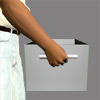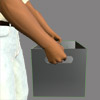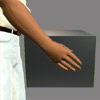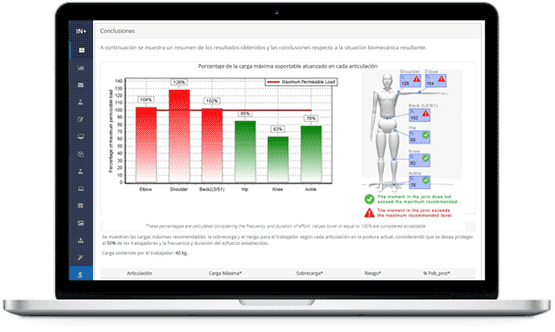

By using the Niosh Equation, it is possible to evaluate tasks that involve lifting loads. The result of the equation is the Recommended Weight Limit (RWL), which is defined as the maximum weight recommended for lifting under the task conditions in order to minimize the risk of back pain or injuries. Additionally, the equation's result can be utilized to assess the likelihood of developing disorders based on the lifting conditions and weight lifted. The intermediate results derived from the equation's application can help identify necessary adjustments to improve the task's lifting conditions.
Several studies confirm that approximately 20% of all workplace injuries are back injuries, with around 30% resulting from overexertion. These statistics emphasize the importance of accurately evaluating tasks that involve lifting loads and ensuring proper job conditioning. In 1981, the United States' National Institute for Occupational Safety and Health (NIOSH) published the first version of the NIOSH Equation. A second version, released in 1991, incorporated advancements in the field, allowing for the evaluation of asymmetrical lifting, non-optimal load grips, and an expanded range of lifting times and frequencies. This updated version also introduced the Lifting Index (LI), an indicator that helps identify hazardous lifting.
Remember...
Use the Niosh Equation to evaluate tasks that involve load lifting.
Several studies indicate that around 20% of all workplace injuries are back injuries, and about 30% are due to overexertion. These data provide an idea of the importance of a correct evaluation of tasks that involve load lifting and the proper conditioning of the workstations involved.
Essentially, the equation is defined by three fundamental criteria: biomechanical, physiological, and psychophysical.
The biomechanical criterion is based on the fact that when handling a heavy load or a light load that is improperly lifted, mechanical moments are generated, which are transmitted through the body segments to the lumbar vertebrae, resulting in significant stress. By using biomechanical models and data collected from studies on the resistance of these vertebrae, a value of 3.4 kN was determined as the compression force limit on the L5/S1 vertebra for the risk of back pain to occur.
The physiological criterion is based on the fact that tasks with repetitive lifting can easily exceed the normal energy capacities of the worker, causing a premature decrease in their resistance and an increased probability of injury. The NIOSH committee collected limits of maximum aerobic capacity for the calculation of energy expenditure and applied them to their formula. The maximum aerobic lifting capacity was set to apply this criterion at 9.5 kcal/min.
Finally, the psychophysical criterion relies on information about workers' endurance and capacity when handling loads at varying frequencies and durations, taking into account the combined biomechanical and physiological effects of lifting.
The method starts by defining an ideal lift, which is performed from the Standard Lifting Location, as defined by NIOSH, and under optimal conditions. This entails lifting in the sagittal plane (without torso twists or asymmetrical postures), executing an occasional lift, maintaining a secure grip on the load, and lifting it less than 25 cm.
The Standard Lifting Location (Figure 1) is the position considered optimal for lifting loads; any deviation from this reference is deemed a departure from ideal lifting conditions. This standard posture occurs when the horizontal distance (projected on a horizontal plane) between the grip point and the midpoint between the ankles is 25 centimeters, and the vertical distance from the grip point to the ground is 75 centimeters.
For an ideal lift, the recommended maximum weight is 23 kg. This value, known as the Load Constant (LC), is based on psychophysical and biomechanical criteria, and represents the weight that can be safely lifted by 75% of women and 90% of men under these conditions. In other words, the Recommended Weight Limit (RWL) for an ideal lift is 23 kg. However, some studies suggest that the Load Constant (LC) can be adapted to the individual's specific conditions when performing a lift. For instance, when the lift is carried out by a woman under 45 years old, the LC can be set at 20 kg; if she is 45 or older, the LC can be reduced to 15 kg. For men aged 45 or older, the LC can also be reduced to 20 kg. In any case, it is not advisable to increase the LC above 23 kg, unless the lifting task is performed by a worker with exceptional abilities or training.
The Niosh Equation calculates the Recommended Weight Limit using the following formula:
RWL = LC · HM · VM · DM · AM · FM · CM
NIOSH Equation
In the NIOSH equation, LC stands for the Load Constant, and the remaining terms on the right-hand side of the equation are multiplier factors. These factors take a value of 1 for optimal lifting conditions, and approach 0 as the lifting conditions deviate further from the ideal situation. As a result, the Recommended Weight Limit (RWL) is equal to the Load Constant (23 kg) in the case of an optimal lift, and decreases as the lifting technique worsens.
Remember...
The ideal lift would be performed from the standard lifting location, in a sagittal position, making an occasional lift, with a good grip on the load and lifting it less than 25 cm.
Remember...
The Constant Load (LC) is the maximum weight that could be lifted without problems, in a lift under ideal conditions, by 75% of women and 90% of men.
According to NIOSH, the Constant Load (LC) is 23 kg. Sometimes, the Load Constant (LC) can be adapted to the individual's specific conditions when performing a lift. In any case, it is not advisable to increase the LC above 23 kg, unless the lifting task is performed by a worker with exceptional abilities or training.
The implementation of this method starts by observing the worker's activities and identifying each task performed. Based on these observations, it must be determined whether the activity will be analyzed as a single task or multitask.
A multitask analysis should be chosen when the variables to consider vary considerably between lifts. For instance, if the load is picked up from various heights or the weight of the load differs between lifts, the activity will be divided into separate tasks for each type of lift, and a multitask analysis will be conducted. This analysis entails gathering information from each task, applying the NIOSH equation to each, and then calculating the Composite Lifting Index. If the lifts do not exhibit significant variations, a single-task analysis will be performed.
Next, for each identified task, it is essential to determine if there is significant control of the load at the lift's destination. Generally, the most challenging part of a lift is the beginning, as it requires the most effort. As a result, measurements are typically taken at the origin of the movement, from which the recommended weight limit is derived. However, in specific tasks, releasing the load may demand efforts comparable to or greater than lifting it. This typically happens when the load must be placed precisely, remain suspended for some time before being positioned, or the placement location has limited access. In such cases, we say that the lift requires significant control of the load at the destination. Both the beginning and the end of the lift must be evaluated, applying the NIOSH equation twice, selecting the least favorable (lowest) recommended weight limit (RWL) and the highest Lifting Index (LI). For example, taking boxes from a conveyor table and placing them neatly on a top shelf of a rack may require significant control of the load at the destination, as the boxes must be positioned in a particular manner and access might be challenging due to height.
After determining the tasks to be analyzed and whether there is control of the load at the destination, the relevant data must be collected for each task. This data should be gathered at the lift's origin, and if there is significant control of the load at the destination, also at the lift's destination.
The data to be collected includes:
The Weight of the object being handled, in kilograms, including any potential container.
The Horizontal distance (H) and Vertical distance (V) between the grip point and the projection on the ground of the midpoint of the line connecting the ankles (refer to Figure 1). Measure V at both the starting and ending points of the lift, irrespective of the level of load control.
The Frequency of lifts (F) for each task, which refers to the number of times per minute the worker lifts the load. Observe the worker for 15 minutes while performing the task and calculate the average number of lifts per minute. If the same task yields differences of more than two lifts per minute across different work sessions, consider dividing it into separate tasks.
The Duration of the lift and the Recovery times, which involve determining the total time spent on lifts and the recovery time following a lifting period. Recovery time includes periods of light activity, unrelated to lifting, such as sitting at a computer, monitoring operations, or performing assembly tasks.
The Type of grip, categorized as Good, Regular, or Poor. Further sections will outline how to classify various grip types.
The Asymmetry angle (A), formed by the worker's sagittal plane and the center of the load (see Figure 2). This angle reflects the worker's trunk torsion during lifting, both at the beginning and end of the lift.
Remember...
A multi-task analysis will be chosen when the variables to consider in different lifts vary significantly.
Multi-task analysis requires collecting information from each task, applying the NIOSH equation for each one, and subsequently calculating the Composite Lifting Index.
Remember...
There is significant control of the load at the destination of the lift when the load must be placed precisely, must be suspended for some time before placing it, or the placement location has difficult access.
In these cases, the beginning and the end of the lift should be evaluated by applying the NIOSH equation twice, selecting the least favorable RWL (the lowest).
Remember...
The Lifting Index is calculated as the quotient between the weight of the lifted load and the recommended weight limit calculated for the task.
If the LI is less than or equal to 1, the task can be performed by most workers without causing them problems.
If the LI is between 1 and 3, the task may cause problems for some workers. It is advisable to study the workstation and make the appropriate modifications.
If the LI is greater than or equal to 3, the task will cause problems for most workers. It must be modified.
After completing the data collection, proceed to calculate the multiplier factors of the NIOSH equation (HM, VM, DM, AM, FM, and CM). The calculation procedure for each factor will be discussed in later sections. With these factors determined, the Recommended Weight Limit (RWL) value for each task can be obtained by applying the equation.
For tasks involving significant control of the load at the destination, calculate an RWL for the starting point of the displacement and another for the destination. In such tasks, the RWL will be the least favorable of the two, that is, the smallest value. The RWL for each task represents the maximum weight recommended for handling under the analyzed lifting conditions. If the RWL is greater than or equal to the weight lifted, the task is considered safe for most workers. However, if the RWL is less than the actual weight lifted, there is a risk of back pain and injuries.
Once the RWL is determined, calculate the Lifting Index (LI). It is crucial to distinguish between single-task and multitask analyses when calculating the LI. The procedure for calculating the LI in the case of multitask analysis will be explained later.
For single-task evaluations, the Lifting Index is calculated by dividing the weight of the lifted load by the computed recommended weight limit for the task.
LI = Weight of the lifted load / RWL
Lifting Index
Finally, the risk of the lifting task is obtained from the Lifting index (LI). NIOSH identifies three risk intervals:
If LI is less than or equal to 1, the task can be performed by most workers without causing problems.
If LI is between 1 and 3, the task may cause issues for some workers. It is advisable to study the workstation and make appropriate modifications.
If LI is greater than or equal to 3, the task will cause problems for the majority of workers. It must be modified.
In summary, the procedure for applying the method consists of the following steps:
When performing a multitask analysis, a simple average of the various lifting indices for the different tasks may result in a compensation of effects that does not accurately assess the real risk. On the other hand, selecting the highest index to evaluate the overall activity would not consider the increased risk contributed by the remaining tasks. NIOSH recommends calculating a Composite Lifting Index (CLI) The formula for CLI is as follows:
CLI = LIT1 + ∑DLITi
where the summation of the second member of the equation is calculated as:
∑DLITi = (LIT2(F1+F2) - LIT2(F1)) + (LIT3(F1+F2 +F3 ) - LIT3(F1+F2 )) + ...
...+ (LITn(F1 +F2 +F3 +...+Fn )- (LITn(F1 +F2 +F3 +...+Fn-1))
Composite Lifting Index
In this equation:
LIT1 is the highest LI among all the tasks.
LITi (Fj) is the lifting index of task i, calculated at the frequency of task j.
LITi (Fj +Fk) is the lifting index of task i, calculated at the frequency of task j, plus the frequency of task k.
The calculation process is as follows:
Calculate the lifting indices of the single tasks (LITi).
Order the simple indices from largest to smallest (LIT1, LIT2 , LIT3 ..,LITn).
Calculate the accumulated risk increments associated with the different single tasks. This increment is the difference between the risk of the single task at the frequency of all single tasks considered so far, including the current one, and the risk of the single task at the frequency of all tasks considered so far, minus the current one. That is:
LITi(F1+F2+F3 +...+Fi) - LITi(F1+F2+F3+...+F(i-1))
Although it is recommended to calculate the composite lifting index using this accumulated risk equation, other authors consider the possibility of calculating the ILc in three other ways:
Risk sum: adds the indices of each task.
Average risk: calculates the mean value of the lifting indices of each task.
Highest risk: the CLI is equal to the highest of the single lifting indices.
To apply the NIOSH Equation, it is necessary to compute the values of the multiplier factors. In the case of a lift under optimal conditions multiplier factors take a value of 1, and values approach 0 as the deviation from ideal lifting conditions increases. Each multiplier factor assesses a specific lifting condition, and their calculation processes are detailed below.
Remember...
The Multiplier Factors in the NIOSH Equation are:
HM: Horizontal Distance Factor.
VM: Vertical Distance Factor.
DM: Vertical Displacement Factor.
AM: Asymmetry Factor.
FM: Frequency Factor.
CM: Grip Factor.
This factor penalizes lifts where the load is lifted away from the body. The following formula is used to calculate HM:
HM = 25 / H
Horizontal Distance Factor
In this formula H is the projection on a horizontal plane of the distance between the midpoint of the load's grips and the midpoint between the ankles (Figure 1). Keep in mind that:
If H is less than 25 cm, HM will be assigned a value of 1
If H is greater than 63 cm, HM will be assigned a value of 0
An alternative way to obtain H, rather than direct measurement, is to estimate it from the height of the hands measured from the ground (V), and the width of the load in the worker's sagittal plane (w). To do this, consider:
If V ≥ 25cm ⇒ H = 20 + w/2
If V ≤ 25cm ⇒ H = 25 + w/2
HM should be calculated twice if significant control of the load is present at the destination. For the Origin, the value of H at the beginning of the lift will be used. For the Destination, it will be used the value of H at the end of the lift.
This factor penalizes lifts with a large vertical displacement of the load. The following formula is used to calculate DM:
DM = 0.82 + (4.5 / D)
Vertical Displacement Factor
In this formula, D is the absolute value of the difference between the height of the load at the beginning of the lift (Vo) and at the end of the lift (Vd). Thus, DM gradually decreases as the vertical distance of the lift increases.
D = | Vo - Vd |
Additionally, consider that:
If D ≤ 25cm ⇒ DM will be given a value of 1
D cannot be greater than 175 cm
This factor penalizes lifts that require trunk twisting (asymmetric lifts). In an asymmetric lift the load starts or ends its movement outside the worker's sagittal plane. In general, asymmetric lifts should be avoided. The asymmetry factor is calculated using the following formula:
AM = 1 - (0.0032 * A)
Asymmetry Factor
In this formula, A is the angle of rotation (in degrees) that should be measured as shown in Figure 2. Given the calculation formula for AM, the factor takes the value of 1 when there is no asymmetry, and its value decreases as the angle of asymmetry increases. It will also be considered that:
If A > 135°, we will give AM the value 0
If there is significant control of the load at the destination AM should be calculated twice; with the value of A at the origin of the lift and with the value of A at the destination.
Penalizes lifts performed frequently, over long periods, or without recovery time. The frequency factor can be calculated from Table 1 based on the duration of work, and the frequency and vertical distance of the lift. As already indicated, the lifting frequency is measured in lifts per minute and will be determined by observing the worker in 15-minute periods. Table 2 should be used to calculate the task duration requested in Table 1.
| FREQUENCY lifts/min |
WORK DURATION | |||||
|---|---|---|---|---|---|---|
| Short | Moderate | Long | ||||
| V<75 | V>75 | V<75 | V>75 | V<75 | V>75 | |
| < 0,2 | 1,00 | 1,00 | 0,95 | 0,95 | 0,85 | 0,85 |
| 0,5 | 0,97 | 0,97 | 0,92 | 0,92 | 0,81 | 0,81 |
| 1 | 0,94 | 0,94 | 0,88 | 0,88 | 0,75 | 0,75 |
| 2 | 0,91 | 0,91 | 0,84 | 0,84 | 0,65 | 0,65 |
| 3 | 0,88 | 0,88 | 0,79 | 0,79 | 0,55 | 0,55 |
| 4 | 0,84 | 0,84 | 0,72 | 0,72 | 0,45 | 0,45 |
| 5 | 0,80 | 0,80 | 0,60 | 0,60 | 0,35 | 0,35 |
| 6 | 0,75 | 0,75 | 0,50 | 0,50 | 0,27 | 0,27 |
| 7 | 0,70 | 0,70 | 0,42 | 0,42 | 0,22 | 0,22 |
| 8 | 0,60 | 0,60 | 0,35 | 0,35 | 0,18 | 0,18 |
| 9 | 0,52 | 0,52 | 0,30 | 0,30 | 0,00 | 0,15 |
| 10 | 0,45 | 0,45 | 0,26 | 0,26 | 0,00 | 0,13 |
| 11 | 0,41 | 0,41 | 0,00 | 0,23 | 0,00 | 0,00 |
| 12 | 0,37 | 0,37 | 0,00 | 0,21 | 0,00 | 0,00 |
| 13 | 0,00 | 0,34 | 0,00 | 0,00 | 0,00 | 0,00 |
| 14 | 0,00 | 0,31 | 0,00 | 0,00 | 0,00 | 0,00 |
| 15 | 0,00 | 0,28 | 0,00 | 0,00 | 0,00 | 0,00 |
| > 15 | 0,00 | 0,00 | 0,00 | 0,00 | 0,00 | 0,00 |
The task duration requested in Table 1 can be obtained from the following Table:
| Time | Duration | Recovery Time |
|---|---|---|
| ≤1 hour | Short | at least 1.2 times the work time |
| >1 - 2 hours | Moderate | at least 0.3 times the work time |
| >2 - 8 hours | Long |
To consider a task Short, it must last a maximum of 1 hour and be followed by a recovery time of at least 1.2 times the work time. If this condition is not met, it will be considered of Moderate duration. To consider a task Moderate, it must last between 1 and 2 hours and be followed by a recovery time of at least 0.3 times the work time. If this condition is not met, it will be considered of Long duration.
This factor penalizes lifts where the grip on the load is inadequate. The grip factor can be obtained from Table 3 based on the grip type and height. The decision tree shown in Figure 3 can be used for choosing the type of grip.
| GRIP TYPE | V < 75 | V ≥ 75 |
|---|---|---|
| Good | 1.00 | 1.00 |
| Regular | 0.95 | 1.00 |
| Poor | 0.90 | 0.90 |
In general, good grips are those carried out with optimally designed containers with handles or grips, or those on objects without containers that allow a good grasp and where the hands can be comfortably placed around the object.
A regular grip is one carried out on containers with non-optimal handles or grips due to inadequate size, or by holding the object with fingers flexed at 90º.
A poor or bad grip is one carried out on poorly designed containers, bulky, irregular, or edged objects, and those held without flexing the fingers, pressing the object against its sides.
 Good
Good
 Good
Good
 Regular
Regular
 Poor
Poor
Originally, the NIOSH Lifting Equation established very strict applicability conditions and did not allow for the evaluation of one-handed lifts or lifts performed by multiple workers. However, both in practice and in research, and as stated in the EN 1005:2 standard, one-handed lifts or lifts performed by multiple workers can be evaluated.
If the lifting is performed with one hand, a correction factor of 0.6 should be applied to the Recommended Weight Limit (RWL) obtained by applying the equation. Thus, the resulting RWL will be multiplied by 0.6 if the lifting is performed with one hand. On the other hand, it is essential to remember that, according to the EN 1005-2 standard, lifting an object with one hand can be hazardous, and this type of handling should be avoided.
If the lifting is performed by two or more workers simultaneously, a correction factor of 0.85 should be applied to the Recommended Weight Limit (RWL) obtained by applying the equation. Thus, the resulting RWL will be multiplied by 0.85 when the lifting is performed by more than one person. However, although the EN 1005-2 standard states that lifting between two or more people can be planned to reduce the load on the worker, this introduces additional hazards due to the difficulty of coordinating movements and efforts between the two (or more) people performing the lift. Ergonomic design should avoid the need to use two (or more) people for lifting, except in special circumstances, for which a risk assessment should be carried out.
Remember...
If the lifting is performed with one hand, a correction factor of 0.6 should be applied to the Recommended Weight Limit (RWL) obtained by applying the equation. Thus, the resulting RWL will be multiplied by 0.6.
Remember...
If the lifting is performed by two or more workers simultaneously, a correction factor of 0.85 should be applied to the Recommended Weight Limit (RWL) obtained by applying the equation. Thus, the resulting RWL will be multiplied by 0.85.
The evaluated task must met several conditions when using the NIOSH Lifting Equation. If these conditions are not met, an analysis of the task by other means will be necessary. A task must meet the following criteria to be appropriately evaluated with the NIOSH Lifting Equation:
The load handling tasks that typically accompany lifting (holding the load, pushing, pulling, transporting, climbing, walking, etc.) should not represent a significant energy expenditure compared to the lifting itself. In general, they should not account for more than 10% of the worker's activity. The equation will be applicable if these activities are limited to taking a few steps or a slight maintenance or transportation of the load.
There should be no possibility of falls or sudden increases in load.
The thermal environment should be adequate, with a temperature range between 19ºC and 26ºC (66ºF and 79ºF) and a relative humidity between 35% and 50%.
The load should not be unstable, and lifting should not be performed while seated or kneeling, nor in confined spaces.
The coefficient of friction between the floor and the worker's shoe soles should be sufficient to prevent slipping and falling, ranging between 0.4 and 0.5.
No carts or elevators should be used.
The risk of lifting and lowering the load should be similar.
Lifting should not be excessively fast, not exceeding 76 centimeters (30 inches) per second.
Diego-Mas, J.A., Poveda-Bautista, R. y Garzon-Leal, D.C., 2015. Influences on the use of observational methods by practitioners when identifying risk factors in physical work. Ergonomics, 58(10), pp. 1660-70.
Garg, A, Chaffin, D.C. y Herrin, G.D., 1978., Prediction of metabolic rates for manual material handling jobs, American Industrial Hygiene Association Journal, 39, pp. 661-764.
Niosh, 1981. Work practices guide for manual lifting. NIOSH Technical Report nº 81-122, National Institute for Occupational Safety and Health. Cincinnaty. Ohio
Waters, T.R., Putz-Anderson, V. Y Garg, A, 1994. Applications manual for the revised Niosh lifting equation. National Institute for Occupational Safety and Health. Cincinnaty. Ohio
Diego-Mas, Jose Antonio. Ergonomic Assessment of Load Lifting Using the NIOSH Equation. Ergonautas, Universidad Politécnica de Valencia, 2023. Available online: https://www.ergonautas.upv.es/ergoniza/app_en/land/index.html?method=niosh
A cloud based software that integrates more than 20 tools for managing the ergonomics of the workstations in your company.
Evaluate all ergonomic risk factors of the workstations in your company: inadequate postures, repetitive movements, load handling, thermal environment...

Use Artificial Intelligence for the automated detection of postures in photographs or videos.
Generate fully customizable reports in Microsoft Word or Adobe Pdf format.
In a multiuser environment so that your company can have access to your data everywhere.
You only need a free account on Ergoniza
ERGONIZA allows you to use Artificial Intelligence for postural load assessment. Automatically capture workers’ postures from a photograph or a video and obtain an automated evaluation of the risk associated with inadequate or forced postures.
AI in actionERGONIZA helps you manage the ergonomics of the workstations of your companies. Evaluate all the risk factors present in the workstations, manage the evaluations, and obtain editable and customizable reports.
You only need to register as a user of ERGONIZA to start testing.
Sign UpUnlock the full potential of Ergoniza. By becoming a Pro User you'll have access to all of Ergoniza and be able to use all of the online software without restrictions or time limits. You'll be able to use the results of evaluation methods and tools in your professional activity. You'll be able to print the results reports in pdf or Word and save your studies in files to open them later.
To register as a Pro user, you must first login to Ergoniza.
(*) In European Union countries, the price will be increased with the corresponding VAT.
(**) The price in american dollars has been calculated at the current exchange rate and may vary.
is a web by . Ergonautas is the specialized website in occupational ergonomics and ergonomic assessment of workstations at the . Ergonautas aims to be a useful support tool for the Occupational Risk Prevention and Ergonomics professional and people in training, providing rigorous technical information on occupational ergonomics, online tools for its application, research, training, and participation forums.
Ergonautas is formed by a large human team. In addition to technicians and programmers, the Ergonautas team is made up of researchers and professors from the Polytechnic University of Valencia. The team, led by José Antonio Diego Más, is at the forefront of research and teaching in ergonomics, teaching in official degrees and master's degrees, and developing research projects in the field of ergonomics and new technologies oriented towards humans.
If you need to know more, get in touch with Ergonautas
Or follow us on Linkedin
- - -
© 2006 - Universidad Politécnica de Valencia




